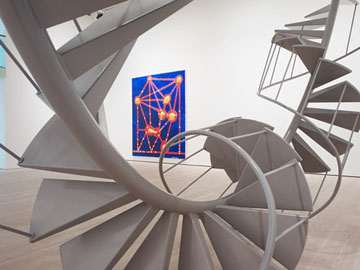
Peter Coffin's "Spiral Staircase" and Chris Martin's "Untitled" at the Saatchi Gallery
If Abstract America, the new show of contemporary American painting and sculpture at the Saatchi Gallery, were a film, it’d be one of those earnest indie dramas made for hipster first dates, with a hand-drawn animated title sequence soundtracked by a Starbucks-endorsed acoustic guitar ballad. In other words, it’s a ruthlessly commercial venture masquerading as counter-cultural event, with the standard-issue indie cinema ironic references (80s hair metal, children’s TV, outmoded junk food) substituted for standard-issue contemporary art ironic references (hard-edge abstraction, action painting, 60s assemblage). It’s a cool show that makes you feel uncool, made by good-looking cool artists (there’s a wall of headshots in one of the galleries, like the lobby of a Chinese restaurant), all of whom I bet claim to have been, like, total nerds in high school.
If abstract art is a kind of faith—something elucidated beautifully in Kirk Varnedoe’s Pictures of Nothing—much of Abstract America is about petulant atheism, a door slammed in the face of a parent. Agathe Snow‘s troika of crucifixes, loaded with detritus (balloons, twigs, knitted spiderwebs, and a pair of—surprise!—Converse shoes), are the first thing you see in the opening room, and they’re as self-consciously ham-fisted as the description suggests. Not that you’d know that from the accompanying text, which breathlessly opines that the construction was “an intensely physical process” (which is at least hyperbole and at most tautology). The author steams up about “the performative dimension of her work,” as though assemblage-style construction were a transcendent act, and, in the mindset that Abstract America stands for, it sort of is. The text is particularly revealing of the transferral of faith that the show evidences, the santification of the artist above the work (that practice over work chestnut again). For example: the text on the work of Kristin Baker, an arch but intermittently engaging painter, salivates over her love of Formula One racing; she “paints for the thrill of the moment…her high-octane abstractions appropriate every essence of high-octane drive” (they don’t). Meanwhile, her Raft of Perseus—a sort of juddering Gericault; Raft of the Medusa via Google Image Search—is described with anachronistic romanticism as “an analogy for the loneliness and heroism of artistic pursuit.” Whether or not that’s intended ironically, it nevertheless encapsulates what’s wrong with the show’s approach. While Baker and her peers have scornfully dumped the good bits of Abstract Expressionism—joyous paint, spiritual or psychological yearning, epic ambition—they’ve kept, in the words of their supporters at least, the bad bits, the tiresome cliches of clench-jawed outsider American cool. And the words of the supporters are all. This is art that prioritizes the word; it’s conceptual first and painting second, and too often the concept clouds visual purchase. Try remembering what a painting from the ground floor looked like once you’re a few floors up and your head crowds with other images. They don’t hold.
That’s not always the art’s fault, though. The Saatchi Gallery is a vast institutional space, like a municipal swimming pool from the future, whose epic scale and boxy presentation forces staccato curatorial statements rather than a gradual eking out of links and echoes. There are some great works here trapped into airless corners. A recent Mark Bradford painting, a scree of arachnid lines scratched through a palimpsest of collaged papers, filters outsiderish obsessiveness through urban geography. A suite of Mark Grotjahn paintings, dizzying orthogonals in creamy monotone laid in layers a few milimeters thick, can be cute but play out their stonerish time-and-space theme with wonky charm. (His signatures are the best in the business). And in the top floor galleries, a room of Amy Sillman abstractions feels as though the windows have been suddenly thrown open. Muscular and confident as de Kooning in his prime, with a lovely quirky sensibility that never tips into self-conscious kookiness, her paintings offer the kind of fizzing, pinball visual excitement that provide a pretty decent argument for the primacy of abstract art, whoever and whenever you are.
I (and the gallery) have been using the word “abstraction” to describe these works, but the title is a misnomer; there’s plenty of loosely figurative work here. The majority of the work is, I suppose, about abstraction (or at least about the American abstract tradition). Any painting, figurative or not, is an abstraction of the visual world in any case, and the semantic slipperiness is apt for many of the show’s genre-hopping works. There’s a question that hangs over the show, though: why abstract art? Why now? What’s the point? “Whatever,” by the way, doesn’t count.



